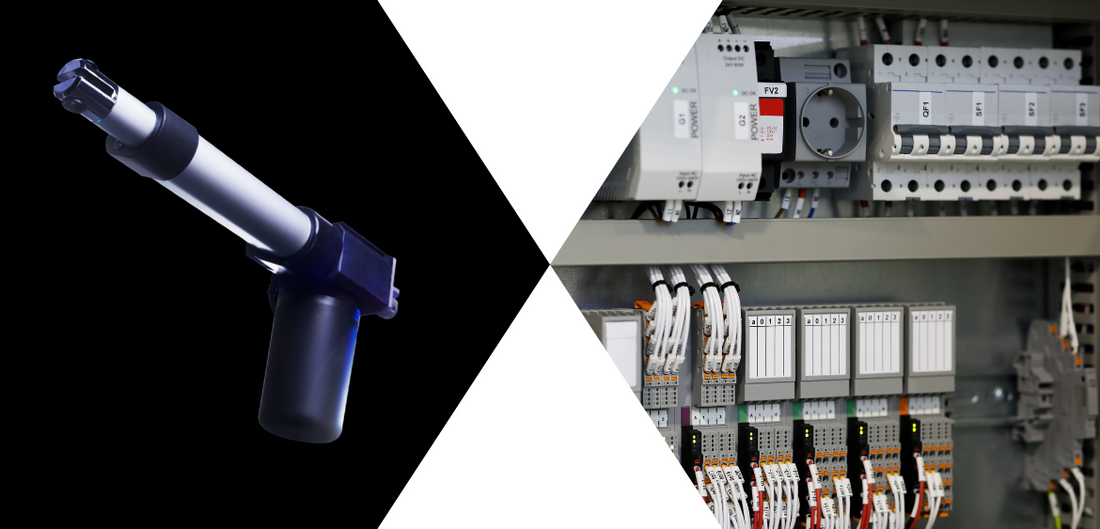Electric linear actuators and PLCs are among the major pieces of electronic equipment which play a crucial role in the operation of nearly every machine, process, and equipment we encounter. In the industry, there is a large range of different PLCs and electric linear actuators to choose from. Because of this, compatibility between each device may not always be straightforward, especially if the components were from different manufacturers. We will be covering the important aspects to consider when integrating electric actuators with PLCs for unified two-way communication.
Choosing the Electric Actuators

Each application has its own unique set of requirements that needs to be considered before choosing an actuator. These requirements may include:
- Force requirements
- Travel speed requirements
- Dimensional requirements
- Environmental compatibility
- Feedback compatibility
- Sound/noise level requirements
As there are many different factors to consider when choosing an electric linear actuators, we recommend performing your test procedures to ensure you find the best long-term solution. We also have a free Actuator Testing Guide written by engineers, for engineers to help you on how to select, test, and implement linear motion for any application.
One-Way Communication with Actuators

Linear actuators and control systems with no feedback capabilities are not suitable for two-way communication, however, they may work for applications that only require one-way communication. This is because the actuator can receive power to move after a controller sends output commands, however, the actuator will not be able to send any information back to the controller after changing positions. This style of operation may be suitable for applications that do not require high positional accuracy or precision.
Our pre-built control boxes are mainly designed for one-way communication with our electric linear actuators. This is because they were intended for applications that have a user monitoring the actuator’s movements while also operating their handheld remote control. If you were interested to know more about our FLTCON control boxes and their communication protocol, please reach out to us directly.
Two-Way Communication with Actuators

Two-way communication requires the ability to send and receive signals between the electric linear actuator and its PLC (programmable logic controller). Positional feedback from an electric linear actuator is essential for two-way communication as this will allow its controller the ability to read position and then use this information to execute the next set of commands. In more sophisticated use cases, the feedback can be used to not only achieve precise speed and position, but also the desired dynamic response, synchronization, and stability.
We offer two major types of positional feedback that are practical for two-way communication:
- Hall effect sensor feedback
- Potentiometer feedback
Each type of positional feedback has its own benefits and drawbacks that need to be considered. A standard electric linear actuator from off the shelf may not always come with the type of positional feedback you desired, however, this does not limit us from custom manufacturing to your needs. Please reach out to us if you would like to learn more.
Driving the Electric Actuators

Most of our in-stock linear actuators require 12 VDC for operation of their brushed DC motors, however, we have a few models that utilize 24 VDC motors. Choose PLC power supply modules for 12V or 24V based on the operating voltage of your chosen actuators. It is also important to ensure the power supply modules have the appropriate current rating for the number of actuators being used.
After acquiring electrical power, your PLC system will then need an H-bridge for physically diverting the current path to change an actuator’s travel directions. The dual relay H-bridge modules, dual relay H-bridge external circuits or H-bridge breakout boards are suitable options to consider. Once you have chosen the H-bridge that works best for your specific PLCs, ensure there is one H-bridge per actuator being controlled and verify that the current capacity for each H-bridge is within the requirements of the chosen actuator model.
Electrical Protection and Safety

It is always crucial to consider the safety and protection you will need for your electrical system. Integrating an in-line fuse to your motor circuit is a simple yet helpful means of protecting your electronic components from short circuits. Due to the in-rush current from our actuator’s DC motor, we recommend choosing a motor starting fuse or time delay fuse. Choose a fuse with the suitable current ratings which can be determined by finding out the maximum current draw of your application and using the equation below:
Fuse Current Rating = Actual Current/0.75
Acquiring Positional Feedback

The power supply modules previously mentioned also enables the ability for PLCs to provide a constant source of power for other electronics such as hall effect sensors and potentiometers for feedback. Our hall sensors are rated for up to 24V; however, we recommend getting a 5V module or step down DC to DC converters if 5V compatibility was required for our potentiometer feedback. Hall sensors from different manufacturers may also require 5V for proper operation. Supplying a lower input voltage to positional feedback devices helps in reducing the risk of electrical overload due to excessive voltage. The step down DC to DC converters will use the same power supply as the actuators for its source.
Hall Effect Sensors

A hall effect sensor is an electronic component that generates a voltage based on the strength of the magnetic field flowing through it. When this sensor is paired with voltage threshold detecting circuitry a signal with two states can be produced. In our actuators, the hall effect sensor is designed to produce a two-channel signal with the waveforms quantified in either of two binary states: on, or off. These two signals will rise and fall as the electric motor rotates with a 90° phase difference between them. The frequency of these pulses as they relate to the change of position in the actuator is dependent on their overall resolution and differs between our different actuators. Integrating a hall encoder reader module will enable two-way communication between PLCs and hall effect sensor actuators similar to the PA-04-HS.

Potentiometer Feedback

The potentiometers inside our actuators with positional feedback work like voltage dividers with a large resistor for providing direct angular position information of the motor shaft. As a result, the potentiometer can retain its positional information even if the system loses electrical power. The actual resistance value for each of our potentiometers may vary within the 0-10kΩ range depending on the actuator model and stroke length. Integrating an analog input module will enable two-way communication between PLCs and potentiometer feedback actuators similar to the PA-14P. Readings from the potentiometer’s voltage signal could range somewhere from 0 to 5V, however, Signal Conditioning Amplifiers (SCA) can also be integrated if your system required signal amplification.

In Summary
The versatility of electric linear actuators combined with the robustness of PLCs allows for reliable automation solutions in a broad range of applications. By choosing the right equipment and supplies, our electric linear actuators can now be integrated with PLCs for unified two-way communication.
As one of the top suppliers of electric linear actuators and motion control products, Progressive Automations offers industry-leading flexibility, quality, support, and field experience to meet all your needs. If you have any other questions about what we can offer, please do not hesitate in reaching out to us! We are experts in what we do and want to ensure you find the best solutions for your application.
sales@progressiveautomations.com | 1-800-676-6123




